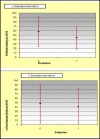Diabetes effect on Quality of Life in the long-term after Limb salvage with Infrageniculate Bypasses accompanied with minor amputations
- PMID: 25225523
- PMCID: PMC4163229
- DOI: 10.12669/pjms.305.5226
Diabetes effect on Quality of Life in the long-term after Limb salvage with Infrageniculate Bypasses accompanied with minor amputations
Abstract
Objective : To evaluate the quality of life in patients, who had their limbs salvaged with an infrageniculate bypass and minor amputation in the long term and to see if diabetics are prone to worse results.
Methods: The patients with limb salvage following an infrageniculate bypass and minor amputation were asked to complete Short Form 36 at the last follow-up visit. The mean scores in diabetic and non-diabetic population were compared to each other .The mean follow-up period was 58±8 months. Results : Of 142 patients, 40 patients were eligible to be included in the study. 33 (82.5%) patients were male and 7 (17.5%) patients were female. The mean age at the time of intervention was 57±14 (33-83) years. The mean scores for eight domains of SF-36 evaluation ranged from 44 to 67 out of 100. There were no significant differences concerning the mean scores of any dimension between the diabetic and non-diabetic group. Conclusion : Despite a minor amputation, the functional outcome of limb salvage with an infrageniculate bypass is favorable and diabetes does not seem to have negative effect on the functional outcome and Quality of Life.
Keywords: Buerger’s Disease; Diabetes Mellitus; Peripheral Vascular Disease; Quality of Life.
Figures
Similar articles
-
Improvement of quality of life six months after infrageniculate bypass surgery: diabetic patients benefit less than non-diabetic patients.Eur J Vasc Endovasc Surg. 2006 Aug;32(2):182-7. doi: 10.1016/j.ejvs.2006.02.007. Epub 2006 Mar 29. Eur J Vasc Endovasc Surg. 2006. PMID: 16567116
-
Limb salvage after successful pedal bypass grafting is associated with improved long-term survival.J Vasc Surg. 2001 Jan;33(1):6-16. doi: 10.1067/mva.2001.112300. J Vasc Surg. 2001. PMID: 11137918
-
Efficacy of infrainguinal bypass for limb salvage in young diabetic patients.J Diabetes Complications. 2000 Sep-Oct;14(5):255-8. doi: 10.1016/s1056-8727(00)00121-5. J Diabetes Complications. 2000. PMID: 11113687
-
Early results of lower extremity infrageniculate revascularization with a new polytetrafluoroethylene graft.Vascular. 2004 Sep-Oct;12(5):318-24. doi: 10.1258/rsmvasc.12.5.318. Vascular. 2004. PMID: 15765913
-
Redo infrainguinal bypass: factors predicting patency and limb salvage.Ann Vasc Surg. 2003 Sep;17(5):492-502. doi: 10.1007/s10016-003-0040-z. Epub 2003 Sep 10. Ann Vasc Surg. 2003. PMID: 12958672
References
-
- Aronow H. Peripheral arterial disease in the elderly: recognition and management. Am J Cardiovasc Drugs. 2008;8:353–364. - PubMed
-
- Norgren L, Hiatt WR, Dormandy JA, Nehler MR, Harris KA, Fowkes FG, et al. Inter-Society Consensus for the Management of Peripheral Arterial Disease (TASC II) Eur J Vasc Endovasc Surg. 2007;33:S1–75. - PubMed
-
- Wann-Hansson C, Hallberg IR, Risberg B, Lundell A, Klevsgard R. Health-related quality of life after revascularization for peripheral arterial occlusive disease: long-term follow-up. J Adv Nurs. 2005;51:227–235. - PubMed
-
- Engelhardt M, Bruijnen H, Scharmer C, Wohlgemuth WA, Willy C, Wölfle KD. Prospective 2-years follow-up quality of life study after infrageniculate bypass surgery for limb salvage: lasting improvements only in non-diabetic patients. Eur J Vasc Endovasc Surg. 2008;36:63–70. - PubMed
-
- Chetter IC, Spark JI, Dolan P, Scott DJ, Kester RC. Quality of life analysis in patients with lower limb ischaemia: suggestions for European standardization. Eur J Vasc Endovasc Surg. 1997;13:597–604. - PubMed
LinkOut - more resources
Full Text Sources


